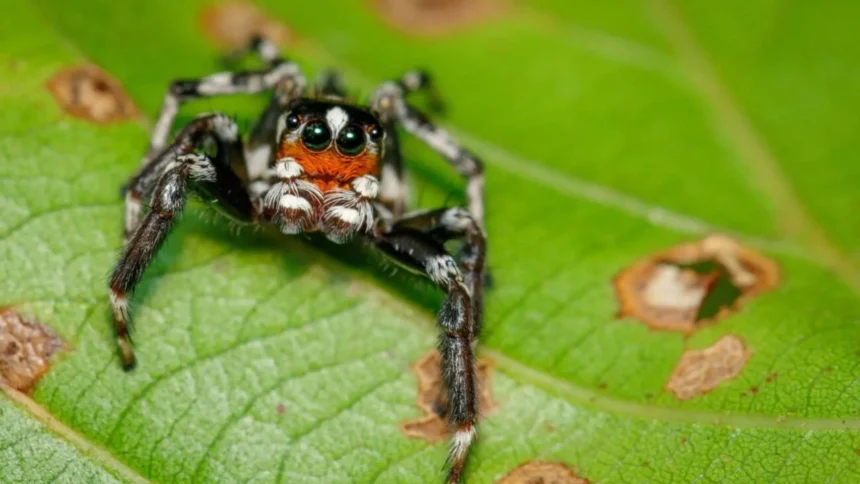What do jumping spiders eat? Jumping spiders, which may seem cute, are hunters themselves and not caught in webs. They search for their food by moving around and attacking swiftly.
Surprisingly, they eat many types of insects like flies or mosquitoes along with crickets and aphids mainly. There are even brave hunters who confront prey bigger than themselves. The food type may change with the jumping spider species and its surroundings.
Jumping Spiders: The Agile Predators
Before we go deeper in “what do jumping spiders eat” we should know about how they hunt. Jumping spiders have very good sight, they possess some of the finest vision in the animal world. Their big eyes with many lenses enable them to view clear and vivid images from far away, which makes these creatures exceptional at spotting possible food sources.
These quick hunters love to chase. They track their insect food, moving and coming near. Then, using a strong leap driven by hydraulic force, they attack the unaware prey. Jumping spiders have the ability to generate a particular kind of silk thread called dragline. They primarily employ it as a safety line when they leap, and sometimes as an anchor for prey or other purposes.
Beyond the Usual
What do jumping spiders eat? Some of the general answers are Flies, crickets and aphids are typical food sources for many jumping spiders.
These jumping spiders have a particular ability to leap very high and move fast. This lets them hunt for food even from creatures that are bigger than themselves. Picture a small jumping spider capturing a housefly many times its size – this is truly an interesting show of hunting skill.

Flies are a usual target, but occasionally jumping spiders could also include moths or other insects that fly. The essential point is the prey should be in a size range that the spider can overcome and control.
You might find it hard to believe, but some jumping spiders, especially the larger ones, will try to hunt prey that appears ridiculously big from our standpoint. Small frogs, lizards or even young mice, these audacious hunters will give it a shot!
It may amaze you to know that some types of jumping spiders have been seen drinking nectar from flowers. Although this is not their main way of getting food, it indicates they could also be having a varied diet.
Dietary Variations Across the Salticidae Family
Jumping spiders are not all alike so the answer to our question “what do jumping spiders eat” may not be the same every time. There exist more than 6,000 species of them. So when it comes to what they eat, you cannot use a general rule for all jumping spiders. The Salticidae family is very diverse and includes many types of jumping spiders. A jumping spider in a big rainforest will have different things to hunt compared to one that lives in the desert.
This variety lets them change as per their environment and find out the best food sources around them. Jumping spiders have a wide menu, eating various kinds of small animals like insects, arachnids, and other spiders.
Jumping Spiders as Beneficial Predators
The answer of “What do jumping spiders eat” is beneficial to us. Jumping spiders, small yet powerful creatures, are like nature’s professional killers. They eat flies and aphids along with other typical insect annoyances found in gardens that keeps their population under control and prevents them from becoming too numerous.
Such natural pest control aids in maintaining a good equilibrium within the ecosystem. No fear if you discover a jumping spider in your home; they are good visitors. These spiders possess excellent vision and hunting skills, making them efficient at capturing flies, mosquitoes and other insects that might intrude inside.
Keeping Jumping Spiders as Pets

The Knowledge of “what do jumping spiders eat” is necessary if you want to keep them as pets. People are increasingly fascinated by jumping spiders, and they keep them as unusual pets because of their cleverness and special look. Variety in the types of insects offered is also crucial to make sure they get all the nutrients needed. Fruit flies that cannot fly are an ideal choice for slings while pinhead crickets or mealworms can be given to older juveniles and adults.
Fun Facts About What Do Jumping Spiders Eat
An example is Evarcha culicivora, a spider that specializes in eating mosquitoes. It focuses on blood-fed female Anopheles mosquitoes which transmit malaria. Juveniles possess a different hunting tactic, coming near to the mosquito from its backside and biting beneath the thorax for firm hold. Recent study hints that some jumping spiders may be choosier eaters than we presumed before.
Myths and Misconceptions About Jumping Spider Diets
Even though they have eight legs and look scary, jumping spiders don’t want human blood. Their digestive system can handle insects but not the complicated composition of our blood. Cats or dogs that are big house pets also fall into this category. Jumping spiders are not big enough to catch such prey, and their hunting habits center on insects that fit within their size range. Jumping spiders are captivating hunters who prefer insects as food, not human flesh or your pet’s fur ball.
Jumping spiders, because of their remarkable eyesight and bold hunting methods, can be considered the acrobatic hunters in the world of insects. They eat many different things which shows their ability to adapt themselves. Also, they work as natural controllers of pests which makes them useful helpers too.


Leave a Reply